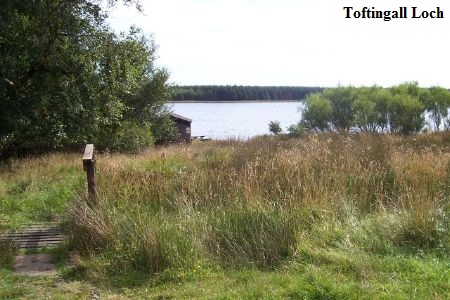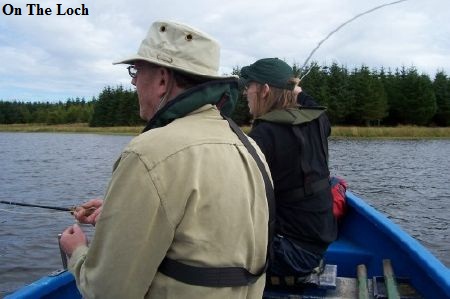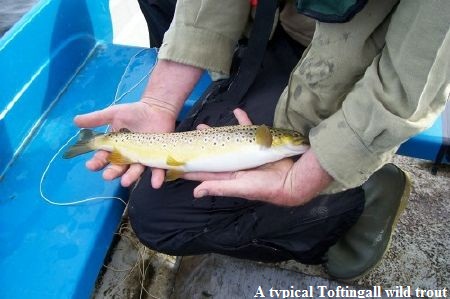A day on Toftingall
- Details
- Published on Monday, 28 May 2007 12:51
- Written by editor
 I turned off the small road that had wound its way out of the village of Watten and stopped to open the first barred gate that sat on the forestry track into Loch Toftingall. After pulling the car past the gate, I closed it behind me. I then drove the short distance to a second gate
I turned off the small road that had wound its way out of the village of Watten and stopped to open the first barred gate that sat on the forestry track into Loch Toftingall. After pulling the car past the gate, I closed it behind me. I then drove the short distance to a second gate
and repeated the process but this time unlocking the padlock with one of the two keys I had received from Hugo Ross in his Wick tackle shop earlier that morning.
The scenery change was almost instantaneous as I moved past this last gate. Instead of the fields rimmed with upended slabs of Caithness stone and swathes of blazing yellow gorse, I now plunged into the enclosing greenery of a forestry plantation. I nosed the car along the muddy track that wound its way into the heart of Moss of Toftingall before straightening out into a long corridor between the closely cosseted ranks of evergreens. Stopping the car in the small parking area at the end of this corridor, I got out and stood for a while, looking over the harbour area onto the waters of Toftingall loch for the very first time. All was quiet.
 It always strikes me as strange as to how few birds you will hear singing in planted forestry. Sometimes it almost feels like even though the surroundings should be bursting with life, they are really a little sterile. Peering under the low canopy of needle encrusted branches, my eyes could not penetrate the darkness more than three rows back. Beautiful on the outside but not quite right if you scratch the surface.
It always strikes me as strange as to how few birds you will hear singing in planted forestry. Sometimes it almost feels like even though the surroundings should be bursting with life, they are really a little sterile. Peering under the low canopy of needle encrusted branches, my eyes could not penetrate the darkness more than three rows back. Beautiful on the outside but not quite right if you scratch the surface.
Selecting the new Lomond boat out of the three vessels in the little dock, I loaded up. Oars were brought out of the wooden boathouse, the key to which was the second one I had received in Wick. I strung up a ten-foot rod and attached to the floating fly-line, what has become my standard wet fly leader set up: about eighteen foot long, with three flies six feet apart. Quickly scouting through my fly boxes, I selected a team of Clan Chief to take the top dropper; Green tailed Kate on the middle and a small Jungle Cock Viva on the point. The selection of the point fly was prompted by the finding of a green thorax-ed Montana nymph on the ground near the boats. It had that ragged, chewed upon look that brought a sudden urgency to my search through the selection of flies I had with me. There was no nymph of that type, so I tied on the Viva hoping colouration had been the key factor in a previous anglers success. For good measure, I had also selected the Green tailed Kate ahead of my more usual middle dropper occupant; the standard Kate McLaren.
I embedded the Montana into the wood of the picnic table that sits in front of the boathouse. Leaving it there as a clue for an angler less fussy than I in using flies he had not tied himself.
I was ready. Sweating slightly from the hurriedly loading of the boat. A steady, stiff breeze maintained a small wave on the loch’s surface, but in the harbour area the trees blocked off the air movement, creating a pleasant sun trap. The weather was certainly a relief considering the gale force winds carrying cold rain that had blown me off Loch Watten the previous day. I had managed to force my way out of the east harbour, but half an hour of getting seriously slapped about by the elements saw me seeing sense and heading back into safety. No other boats got out that morning. As I sheltered in the car waiting for an abatement in the conditions, a trail of anglers pulled into the car park, stared disappointedly at the white capped rollers before leaving with world weary expressions. In the early afternoon I headed off for the caravan I was staying in at the other end of Watten, giving best to the weather for that day.
But this was a new day and a new place. Apart from the unseasonably cold air (6 deg.C on the 1st day of June) things were looking good. The sun was shining down from a blue sky past traces of broken white cloud. The waters of Toftingall sparkled in welcome as I pushed out from the still harbour area into the wave that just screamed “wet fly” at me. A Cuckoo joined that welcome with its distinctive cry.
 Twenty to thirty yards out, I allowed the boat to start a southerly drift down the western side of the loch. I had read in a magazine article, written by Bruce Sandison, if memory serves me right, that there are always fish in front of the stand of skinny birch trees just to the South of the harbour. He was right, third cast saw a savage tug to one of my flies right in front of those trees. Loose coils of fly line zipped through my fingers before the flex of my rod and steady pressure exerted brought a violently protesting inhabitant of the loch, splashing to the boat. Ten ounces or so of dark spotted, pale yellow flanked Brown trout was released from the hold of the Green tailed Kate. Admired briefly, then slipped back into its own world. Thank you Bruce.
Twenty to thirty yards out, I allowed the boat to start a southerly drift down the western side of the loch. I had read in a magazine article, written by Bruce Sandison, if memory serves me right, that there are always fish in front of the stand of skinny birch trees just to the South of the harbour. He was right, third cast saw a savage tug to one of my flies right in front of those trees. Loose coils of fly line zipped through my fingers before the flex of my rod and steady pressure exerted brought a violently protesting inhabitant of the loch, splashing to the boat. Ten ounces or so of dark spotted, pale yellow flanked Brown trout was released from the hold of the Green tailed Kate. Admired briefly, then slipped back into its own world. Thank you Bruce.
I found the wind was trying to pull the boat out from the bank, angling the drift out into deeper water. I fished that bank all morning from the boat, occasionally rowing back up into the wind then pulling in closer to the bank as I progressively made my way down the loch. I soon found that the optimum place for taking fish seemed to be right on the edge of the band of weed that lined this shore, especially in front of a shallow bay half way down the water. It was here that the Viva took my biggest fish of the morning, a typical Toftingall beauty of over 12 oz. A succession of fish much akin to my first, fell to the charms of the Kate, with one oddball hanging itself on the Clan Chief. The satisfactory tally for the morning was half a dozen fish by the time I reached the southerly extreme of the loch and turned back for the long row back up to the top end.
As I rowed away from the bottom end, I noted how the reddish brown earth bank dropped directly down three to four feet into the loch. The water movements of the loch were steadily eroding into this shoreline. On the bank above there was a wide strip of heather and grass before you reached the encompassing trees. Some of the heather trailed down over the lip of the undercut bank; curtain like. I could just imagine how later in the summer, fat trout would sit under this bank gulping down bugs as they tumbled off the flowering heather draped into the water. A wonderful thought.
During the morning, some other anglers had arrived. I had seen them working the East shoreline: two in a boat and two ferried over to wade the margins. As I approached the little harbour I found they had all returned across the loch and were now gathered around the picnic table for a spot of lunch. A good idea I thought, so I pulled into the harbour for a little refreshment myself. We chatted as anglers do, talking of such things as weather and flies. One of them had found the Montana nymph and guessed the significance of the find, however on the far side of the loch it had turned out that Bibios were what the fish wanted.
As we ate lunch, we watched tiny trout or maybe minnows snaffling flies being blown onto the water from the large flowering catkins bush next to the boathouse. It was a good reminder that there were still fish to be caught, so soon we were all heading our separate ways back out onto the water. This time I headed the short distance up to the more sheltered north end of the loch. There was still a good ripple here, so I stuck to the same team of wet flies. Maybe it was the peacefulness of the place, but for some reason my usual habit of compulsive fly changing seemed to have fallen away on that early summer day.
 Within minutes of restarting, a fish took one of my flies at a rapid rate of knots. One pound of trout threw its full force of life against 200 pounds of angler. It was never a fair battle, but the sheer ferocity in the fight this fish gave, had me worried once or twice. A splendid specimen of its species, I gently slipped it back into the water having removed the Viva from its maw.
Within minutes of restarting, a fish took one of my flies at a rapid rate of knots. One pound of trout threw its full force of life against 200 pounds of angler. It was never a fair battle, but the sheer ferocity in the fight this fish gave, had me worried once or twice. A splendid specimen of its species, I gently slipped it back into the water having removed the Viva from its maw.
Things slowed down during the afternoon, probably due to the very bright, but cold conditions. Another three fish came to the Kate before I decided it was time to take my leave of Toftingall. I was more than satisfied, even though it was only half past three. Also, I had a boat on Watten that evening.
My fellow anglers had already departed by the time I got the boat docked and the car loaded. The dark green paint of the cars bodywork had a yellow hue to it due to a heavy powdering of pollen that had fallen. Somewhere in or above the heathery verge on the loch’s bank, a skylark sang. As I drove away, I hoped that one day I could again be part of this wonderful place.
Almost exclusively fishing loch and stillwater, Paul has migrated over the years from stocked Rainbow to Wild Brown fishing. With a love for fly-tying, he is particularly fond of using deer hair patterns.
Paul can be easily identified on the loch by his repeated fervoured fly changes, and his habit of consistently missing takes while watching the local wildlife instead of his flies.

